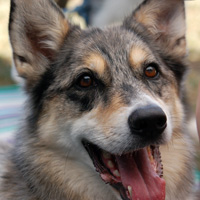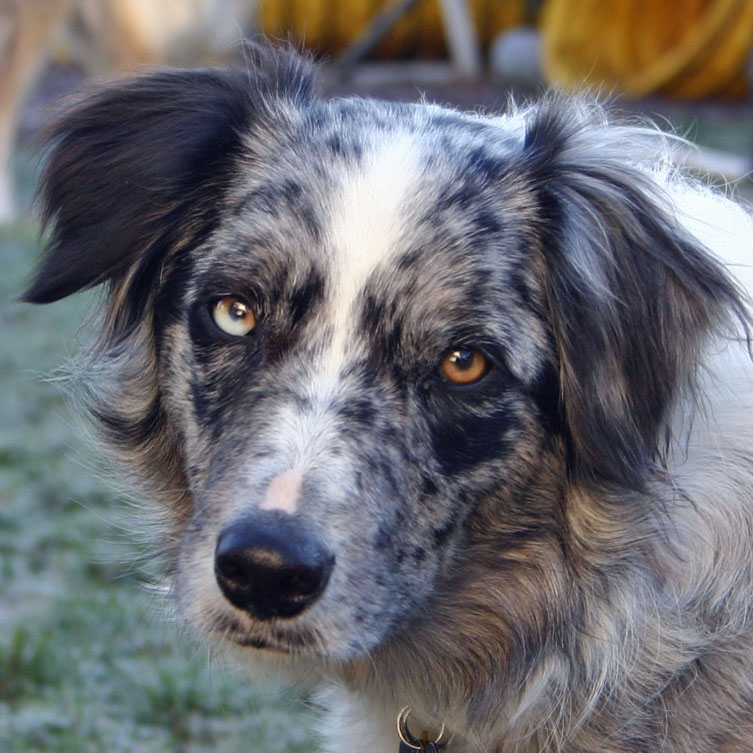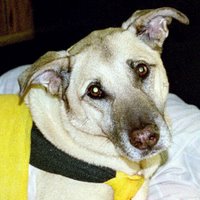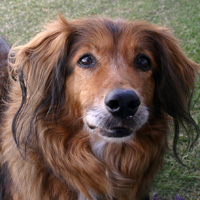Pondering Qualifying for USDAA Nationals
SUMMARY: How the sport has changed; where we fall.
When I first started agility, USDAA tournament events (events that qualify for Nationals--the Grand Prix, the Steeplechase, and the Dog Agility Masters (DAM) Team) were much harder to come by than they are now.
Team Event
Getting to Nationals: Your team has always needed to Q only once (per year) to go to Nationals; I hope that doesn't change! Because ONE Q requires that, at a team event, all three dogs do well in four individual competitions followed by a team relay that's pretty heavily weighted. Even though you "only" need to be in the top 50% of teams at the event with your cumulative scores over those 5 classes, it's sure expensive and time-consuming and stressful to earn that qualifying score.Something that is changing, however, is the nonqualified-dog exemption: In 2004, 2005, and 2006, a team with two Team-qualified dogs could invite a 3rd nonqualified dog for the nationals. I've made use of that exemption every year: In 2004, Tika didn't Q in Team and got on a team with 2 qualified friends; In 2005, one of those friends didn't qualify and joined Tika and another qualified dog; in 2006, two qualified people allowed Boost to join their team (since Boost hadn't started competing soon enough to even try to qualify for the '06 nationals). Starting in 2007, I understand that the exemption will go away. Bummer.
Availability of Team qualifying events: We're actually in one of the hotbeds of dog agility here in central/northern California--we might have more USDAA events, including tournament events, within a couple of hours from home, than anywhere in the country. It started out slowly, though.
In my first full year of competition, I entered only 2 USDAA trials with Remington, and one of them had a DAM (Dog Agility Masters) Team qualifying event. In Remington's 6 years of agility, he entered Team only 3 times, and qualified only once; Jake entered only 3 Team events ever and didn't qualify ever, I don't believe. By comparison, in this last competition year alone, Tika entered four Team qualifying events, with her team qualifying for the nationals twice.
How we've done: Interestingly, in Remington's first Team event, we teamed with (now) long-time friend Karey and her Tervuren, Inyo (now retired), and my obedience instructor, Pam, with her cute little mixed-breed dog, Jake--whom you all now know as MY cute little mixed-breed dog, Jake. I don't really know how it all turned out because, not being as obsessive as I soon came to be about writing down scores, I wrote nothing about the final results after the Relay, nor about what my teammates did. Remington's scores in the 4 individual Team events look pretty good, particularly for a novice dog and handler who couldn't do anything worth beans in the Starters classes(!), but who knows how the cumulative scores from all three dogs plus our relay run ended up.
I do have a cryptic note, "7/11", which I think means that we placed 7th out of 11 teams entered. Even back then, to qualify for the nationals in Team, your team had to place in the top 50%, so clearly we didn't Q in that one.
By comparison, in the last two years, there have typically been more than 60 teams entered in the qualifying events locally.
Grand Prix
Getting to Nationals: When we started, to get to Nationals, you had to complete one Grand Prix during the year with 10 or fewer faults. For Remington's 10 attempts from 1997 to 2001, he succeeded exactly twice--conveniently, once for the 2000 San Diego nationals, and again for the 2001 San Diego event.Sometime after that, the requirement changed to seven or fewer faults--which would have eliminated one of Remington's two Qs, which had 7.03 faults. Later, somewhere between 2001 and 2005, the requirement changed again to two runs with 7 or fewer faults. USDAA's way, I suppose, of trying to reduce the huge numbers of entrants at the National competitions, which were starting to look a little unmanageable.
For the upcoming 2007 Nationals year, once again a change: now you must earn two GPs with five or fewer faults.
I dread every year that they'll change the requirement to zero faults, because of Tika's running style (dropped bars, missed dogwalk up contact): In her 15 qualifying GP runs over the last 4 years, she has run clean only twice. At 5 faults, we can do it--but not if they ever change it.
Availability of Grand Prix Qualifying events: Remington and Jake got to enter one Grand Prix qualifier in each of 1977, 1978, and 1979. In 2000 and 2001, when the Nationals were held in San Diego, we were able to enter two Grand Prixs each year. After that, with the sports' growing popularity, there were two GPs for us again in 2002, four GPs in 2003, seven in 2004, a full ten in 2005, and about the same number available in 2006, although Tika and I didn't run in all of them as my knee deteriorated--
How we've done: For Jake's 19 attempts from 1997 to 2004, he succeeded in Qualifying 12 times, 7 times with no faults at all. What a good little guy.
Fortunately, in 2004, Jake Qed in 4 of his 6 attempts at the Performance level, so we went to Nationals in Performance Grand Prix. In 2005, I didn't enter him in any GPs, instead running him at the nationals in the Veterans category for dogs who had previously made it to at least the semifinals at previous National GPs.
That is something that I've never managed with Tika (so far); with 6 attempts behind us to get to the semis (which you can do by earning a bye at a regional or by doing well at the quarterfinals at the Nationals), we have missed every bloody time. I want that semis polo shirt! And the eventual Veterans designator! Of course, it would be very cool to get to the finals, but I don't think that Tika and I are the team to do it in this competitive environment. I have fantasies about Boost, though--
Steeplechase
Getting to the Nationals: Steeplechase is hard to qualify in--at least, it always seems that way to me, because you have to be in the top some-percentage of dogs in your height class at a qualifying event.In looking at my old records, Remington and Jake each qualified only once in their careers (out of 7 and 6 tries, respectively), and it must've been something like the "top 30%", because both of their Qs were barely under the 30% line.
Sometime before Tika started competing (between 2000 and 2004), it changed to the top 15% of those competing.
Last year, they changed it to something that could in theory allow all dogs to qualify, although practically, it never happens--in fact, given a couple of dogs of much greater speed than most dogs, even fewer could qualify. What they do now is average the score of the top 3 dogs and then qualify all dogs within 125% of their score.
Until this year, you've been able to go to the Nationals with one Steeplechase qualifying score--but in 2007, you'll need two Qs.
Availability of Steeplechase qualifying events: I didn't get a chance to enter Steeplechase in 1996 or 1997, and only once in 1998, 1999, 2000, 2001, 2002, and 2003. Then it exploded in California, most likely because of the Nationals moving to Scottsdale for 2004 and beyond: In 2004, we entered 4; in 2005, seven; in 2006, again seven but I had to withdraw from (I think) two additional ones because of my knee.
How we've done: Even fast Tika has problems with qualifying, because the Steeplechase score ADDS faults to your time, which for example adds 5 seconds if you knock a bar. She didn't qualify in 2 tries in 2003, qualified 1 of 4 in 2004 and 1 of 7 in 2005--which was all she needed in both cases to get to Scottsdale. This year, she actually managed 3 Qs out of 7 tries, which is a good proof that we can do it before the pressure's on next year for the new two-Q requirement. Gulp.
The line just gets higher, and higher, and higher... Complete list of labels






3 Comments:
Raising the bar for tournament events isn't such a bad thing. Not that I've managed yet to qualify with Flirt in GP, though we have a few times in Steeplechase and she's only run twice in team and both my teams E'd all the way around in relay.
But from USDAA's point of view, it keeps people entering local qualifiers more and the impact on the Championships will not reduce the number of entrants, but rather raise the level of the competition at the championships even higher.
I thought it was very interesting that in 22 and 26 inches all the dogs that made it to the podium also had byes to the finals having won a regional GP.
As the quality of the competition improves, the standards should also become more stringent. I imagine you are right, that one day, you will have to qualify in GP with clean runs.
I bet you that Ken is running those numbers as I write, trying to figure out how many people would not have made it to the quarterfinals if the requirement was to run clean. If the numbers are small....well you see where I am going.
/amy
I guess I agree that qualifying for Nationals should prove that you're worthy of being in the Nationals. It's just that--well--it's all about ME ME ME and *I* want to qualify no matter what! :-)
I've heard top competitors saying that it should be clean runs to get to the Nationals, but I'm not entirely sure that I agree with that--unless they make Steeplechase require clean runs, too. That is, in Steeplechase, if you're fast enough, you can qualify with 5 faults because it's scored differently from GP, so why not allow 5 faults in GP? Yes, it's a different kind of event, but still...
I've discussed with people the interesting phenomena that they changed the fault limit from 7 to 5--often preceded by someone saying, why not just change it to 0 faults rather than dropping it by a mere 2 points? My observation is that the only way someone can get between 5.01 and 7 faults in the GP is by being over course time, so by reducing the faults by a mere 2 points, they've removed all the slower dogs from qualifying but left in the fast dogs who sometimes, say, knock bars or miss ups on their dogwalks. Not that I know anyone like that-- ;-)
And, oh yeah, I should mention that the other reason for the explosion of tournament events is that USDAA now requires tournament Qs to achieve your various titles. I'm sure it's good business for USDAA. It certainly makes it more expensive for competitors--
-ellen again
Post a Comment
Links to this post:
Create a Link
<< Home